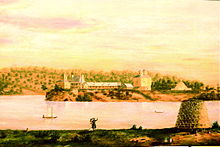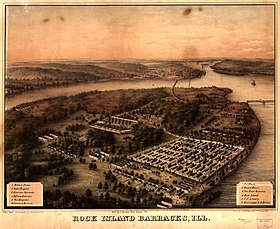Contents


The Rock Island Arsenal comprises 946 acres (383 ha) and is located on Arsenal Island, originally known as Rock Island, on the Mississippi River between the cities of Davenport, Iowa, and Rock Island, Illinois. It is home to the United States Army First Army Headquarters, and the United States Army Center of Excellence for Additive Manufacturing.
Historically the indigenous Sauk Native Americans used Rock Island as their summer camp site. Encroaching European Americans coming into the area disputed the claim of tribal ownership, and competition between the peoples led to the Black Hawk War of 1832. It was named for Black Hawk, the primary leader of the Sauk.
In 1816 the federal government authorized the army to build Fort Armstrong here, to protect shipping on the river in the aftermath of the War of 1812 with Great Britain. Decades after the Civil War, in the 1880s the army established a foundry and armory here, manufacturing both military equipment and ordnance. In 1919–1920 one hundred of the Anglo-American or Liberty Mark VIII tanks were manufactured there, although too late for World War I. The base is now the largest government-owned weapons manufacturing arsenal in the United States. In 1988 the Arsenal was designated a National Historic Landmark.
At the turn of the 20th century, it manufactured both ordnance and leather accoutrements and field gear, for an army that still relied on horses for transportation and cavalry.
Today it provides manufacturing, logistics, and base support services for the United States Armed Forces. The Arsenal is the only active U.S. Army foundry, and manufactures ordnance and equipment, including artillery, gun mounts, recoil mechanisms, small arms, aircraft weapons sub-systems, grenade launchers, weapons simulators, and a host of associated components. Some of the Arsenal's most successful products include the M198 and M119 towed howitzers, and the gun mount for the M1 Abrams, main battle tank for the Army since the 1980s. About 250 military personnel and 6,000 civilians are employed there. The population from the 2020 census was 182 people.
History
From 1816-1862, the site was known as Fort Armstrong. Before that, successive cultures of Native Americans had occupied it for thousands of years because of its strategic position along the Mississippi River.
The United States took control of the island in 1804 through the Harrison Peace Treaty with the Chief of the Fox and Sac Tribes.[3] From 1804 to 1812 the US Army did not occupy the island. It was the scene of a small conflict at the outbreak of the War of 1812 with Great Britain. Following that war, in 1814 it was the site of a U.S. Army expedition from St Louis to use the island as a guard post to control traffic on the Mississippi and maintain watch over the local Native Americans.[3]
Black Hawk wrote in his memoir: "When we arrived we found that the troops had come to build a fort on Rock Island...We did not object, however, to their building their fort on the island, but were very sorry, as this was the best one on the Mississippi, and had long been the resort of our young people during the summer. It was our garden, like the white people have near their big villages, which supplied us with strawberries, blackberries, gooseberries, plums, apples and nuts of different kinds."
During the Civil War, the army converted some facilities and built more in 1863; these were not yet completed in December of that year, when the first Confederate prisoners of war were incarcerated there. The construction was makeshift. The first prisoners were 468 Confederates captured in battles at Chattanooga, Tennessee. That month more than 5,000 Confederates would swell the population of Rock Island military prison. They were kept in 84 barracks, each holding around 100 prisoners.[4]
A total of 41 Confederate prisoners successfully escaped during the prison's operation, and many more would try but fail. They were deterred by the power of the Mississippi River.[5][6]
A total of 1,964 Confederate prisoners and 125 Union guards are buried in the adjacent military cemetery. The Union guard burials included 49 members of the 108th Regiment of United States Colored Troops, who had served as guards. Most of the men died from disease, since sanitation was primitive, as in all army encampments. In addition, they were exposed to high heat and humidity during the summers and freezing temperatures during winters. In 1864, deadly smallpox epidemics rapidly spread through the prison.
The prison camp operated from December 1863 until July 1865, when the last prisoners were freed. After the war, the prison facility was completely destroyed. During its two years in operation, the prison camp housed a total of more than 12,400 Confederates.[5][6]
Other historical sites in the area include the Confederate Cemetery, the Rock Island National Cemetery, 19th-century stone workshops, officers' quarters along the river, Col. Davenport's House, and the site of the first railroad bridge built across the Mississippi.
Following the war, the federal government retained ownership of Arsenal Island. It developed it for use as an arsenal and ordnance manufacturing center, which led to the island being renamed.
Women's history
During the First World War, demand for war materials drastically increased; this increased the demand for skilled labor, but many men were drafted for the war. Women were hired to fill job vacancies at the arsenal. This is often referred to as the "women draft", as they had to backfill the men leaving to fight in order to keep satisfying the war demands from factory production. Rock Island Arsenal increased from having 175 female employees in 1914 to 300 in 1917, a dramatic change before women’s suffrage was approved.[7] Women were absolutely critical to the success of the US buildup in World War I, and played an integral role in production at Rock Island Arsenal.
Early historical timeline
- 1809: Declared a federal military reservation by an Act of Congress[8]
- 1816: Fort Armstrong built on the island
- 1818: George Davenport, U.S. Army sutler established trading post
- 1832: Served as U.S. Army HQ for Blackhawk War
- 1833: George Davenport mansion built
- 1836: Abandoned, but remained ordnance depot
- 1845: George Davenport killed by Banditti of the Prairie
- 1856: First railroad built across the Mississippi River
- 1862: Rock Island Arsenal (the name we know it to be today) established by an Act of Congress
- 1862: First Commanding Officer of Rock Island Major Charles P. Kingsbury.
- 1863-1865: Rock Island Prison Barracks built to house Confederate soldiers
- 1865: Second Commanding Officer of Rock Island Arsenal, Brevet Brigadier General Thomas J. Rodman, also known as the Father of Rock Island Arsenal for his contributions
- 1867: Clock Tower Building erected; it survives and is used as the offices of the U.S. Army Corps of Engineers
- 1871: First military quarters built on Rock Island, an Italianate-style villa known as Quarters One. At 20,000 square feet, it is one of the largest government single-family residences in the United States
- 1872: First Government bridge built across the Mississippi River; replaced the railroad bridge destroyed by a steamboat
Rock Island Arsenal Museum
The Rock Island Arsenal Museum was established on July 4, 1905. It is the second-oldest US Army Museum in the US after the West Point Museum. The museum has been closed twice, during World War I and World War II, to provide more space for manufacturing facilities.
Exhibits interpret the history of Rock Island Arsenal and the Union prison camp during the American Civil War, and the site's role as a military industrial facility. The museum contains the second-largest collection of small arms weapons in the U.S. Army, and an outdoor vehicle display.
See also
- Black Hawk
- American Civil War
- List of Civil War POW Prisons and Camps
- List of National Historic Landmarks in Illinois
References
- ^ "National Register Information System". National Register of Historic Places. National Park Service. January 23, 2007.
- ^ "Rock Island Arsenal". National Historic Landmark summary listing. National Park Service. Archived from the original on 2006-02-13. Retrieved 2007-10-13.
- ^ a b Tillinghast, Benjamin Franklin (1898). Rock Island arsenal: in peace and in war. With maps and illus. Cornell University Library. Chicago : H.O. Shepard.
- ^ The Civil War in America, The Library of Congress
- ^ a b Chestnut, Mary (1982). A Diary from Dixie. Gramercy Books, New York. ISBN 0-517-18266-1.
- ^ a b Speer, Lonnie R. (1997). Portals to Hell: Military Prisons of the Civil War. Mechanicsburg, PA: Stackpole Books, c1997. ISBN 0-8032-9342-9.
- ^ "Arsenal of Democracy: A History of RIA from WWI to WWII". www.army.mil. 23 November 2022. Retrieved 2024-02-25.
- ^ "U.S. Army Official History of Rock Island Arsenal". U.S. Army Official History. 24 February 2024. Retrieved 24 February 2024.
External links
- Historic American Engineering Record (HAER) No. IL-20, "Rock Island Arsenal"
- Official website
- The Rock Island Arsenal Joint Manufacturing & Technology Center (archive link)
- The Rock Island Arsenal profile at globalsecurity.org
- Rock Island Arsenal Museum
- Rock Island Civil War prison (archive link)
- Rock Island National Cemetery, Arsenal, and Confederate POW Camp
- Rock Island Memorial POW Camp #2229
- Rock Island Arsenal Wikimapia


